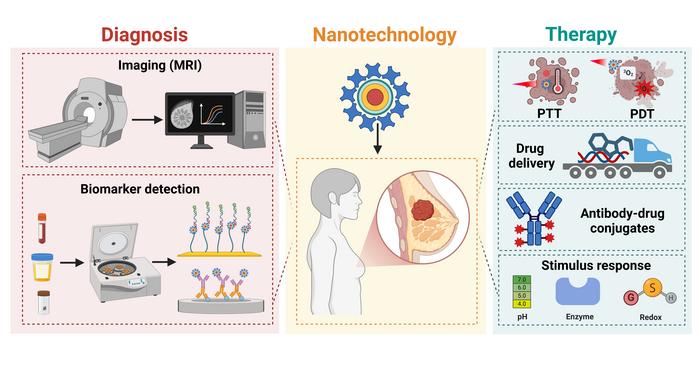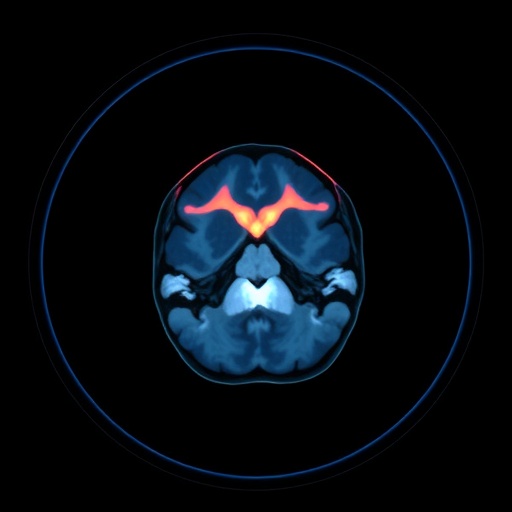
In the evolving landscape of oncology, nanotechnology is emerging as a transformative force in the battle against breast cancer, a disease that affects millions globally with devastating consequences. A comprehensive new review published in the esteemed journal MedComm – Biomaterials and Applications delves into the revolutionary role of nanoparticles in redefining breast cancer diagnosis, prognosis, and therapeutic strategies. Spearheaded by researchers at Sichuan University, this work illuminates how cutting-edge nanoscale innovations can overcome limitations of conventional methods, opening new horizons for precision medicine and personalized care.
Breast cancer remains the most frequently diagnosed malignancy worldwide, with the World Health Organization reporting over 2.26 million new cases in 2020 alone. Particularly challenging is triple-negative breast cancer (TNBC), an aggressive subtype characterized by the absence of estrogen, progesterone, and HER2 receptors. TNBC accounts for approximately 15-20% of breast cancer cases and is associated with a dismal prognosis, exhibiting a mortality rate nearing 40% within five years post-diagnosis in advanced stages. Despite advances in medical technology, early detection and effective treatment of TNBC and other breast cancer types remain elusive with existing modalities.
Current diagnostic tools such as mammography and tissue biopsy afford some utility but possess inherent shortcomings. Mammography may miss tumors in dense breast tissue, while biopsies are invasive and may not fully represent tumor heterogeneity. Therapeutic approaches including surgery, chemotherapy, and radiotherapy are often limited by systemic toxicity, ineffective targeting, and resistance mechanisms, all of which underscore the urgent need for innovative solutions. Nanotechnology, manipulating materials at the scale of billionths of a meter, is rapidly gaining traction as a paradigm-shifting framework that could redefine breast cancer management.
One of the most promising applications lies in nanomaterial-enhanced imaging techniques. Magnetic iron oxide nanoparticles (IONPs) serve as sophisticated contrast agents in magnetomotive optical coherence tomography (MM-OCT), a high-resolution, non-invasive imaging modality. By preferentially accumulating in tumor microenvironments, these nanoparticles significantly enhance contrast, enabling earlier and more precise tumor delineation. Similarly, polymeric nanoparticles engineered for near-infrared (NIR) imaging and phototherapy exploit their exceptional optical properties and functionalization potential, providing dual diagnostic and therapeutic capabilities with minimal collateral damage.
In the realm of biomarker detection, the integration of nanomaterials has yielded ultrasensitive electrochemical sensors capable of rapid and accurate analysis. Carbon nanotubes, renowned for their high surface area and electrical conductivity, offer an ideal platform for detecting hallmark breast cancer biomarkers such as CA 15-3, HER2, and carcinoembryonic antigen (CEA). The enhanced specificity and sensitivity of these nanosensors facilitate earlier detection and assessment of tumor dynamics, critical for tailoring individualized treatment plans and improving patient outcomes.
Therapeutically, nanoparticles have emerged as intelligent drug delivery vehicles that address long-standing challenges associated with conventional chemotherapeutics, including poor solubility, rapid systemic clearance, and off-target toxicity. By conjugating antibodies to nanoparticles, researchers have developed targeted delivery systems capable of homing in on cancer cells with high precision, minimizing adverse effects on healthy tissue. Furthermore, nanoparticle-mediated hyperthermia and photothermal therapies provide minimally invasive modalities that selectively eradicate tumor cells through localized heat generation, offering adjunct or alternative options to surgery and chemotherapy.
Photodynamic therapy (PDT), another promising nanoparticle-enhanced strategy, combines photosensitive agents with controlled light exposure to generate reactive oxygen species that induce cancer cell apoptosis. Nanoparticles improve the solubility, distribution, and controlled release of these photosensitizers, thereby amplifying therapeutic efficacy while reducing systemic toxicity. Beyond these applications, gene therapy utilizing nucleic acid delivery via nanoparticles holds remarkable promise. The efficient transport of siRNA, shRNA, microRNAs, and mRNA enables modulation of oncogene expression or tumor suppressor gene activation at the molecular level—a frontier that could revolutionize treatment paradigms for resistant and refractory breast cancers.
Despite significant breakthroughs, challenges persist that impede the clinical translation of nanoparticle-based technologies. Comprehensive evaluation of nanoparticle toxicity, elimination pathways, and long-term biocompatibility remains paramount to ensure patient safety. Moreover, the lack of standardized large-scale manufacturing protocols and high production costs hinder widespread adoption. Infrastructure demands for nanoparticle storage, handling, and administration further complicate integration into routine clinical practice. Addressing these barriers requires concerted multidisciplinary efforts spanning regulatory science, pharmaceutical engineering, and clinical research.
Looking ahead, the convergence of nanotechnology with emerging fields such as artificial intelligence (AI) and machine learning (ML) offers unparalleled opportunities to accelerate innovation. AI-driven design and optimization of nanoplatforms could tailor properties for maximum efficacy and minimal adverse effects, while ML algorithms analyzing diagnostic and therapeutic data sets may enhance predictive accuracy for treatment response. The development of multifunctional nanoplatforms capable of simultaneous imaging, targeted therapy, and real-time monitoring heralds a new era of personalized oncology wherein treatments are dynamically adapted to the evolving tumor landscape.
“Nanotechnology is rewriting the rules of breast cancer care,” asserts Dr. Li Yang, the corresponding author of the review. “By synergistically merging diagnostic precision with targeted therapeutic delivery, we are transcending traditional boundaries and moving toward a future where cancer is not just treated but outmaneuvered on a molecular level.” This visionary approach encapsulates the transformative potential of nanoparticles to disrupt entrenched paradigms and deliver meaningful clinical benefits.
The review titled “Beyond Conventional Approaches: The Revolutionary Role of Nanoparticles in Breast Cancer” underscores the global momentum toward precision oncology. It synthesizes current research advancements while illuminating future trajectories where nanomedicine could become integral to breast cancer diagnosis and treatment. As this cutting-edge field matures, it promises to significantly improve survival rates and quality of life for patients facing this formidable disease.
For clinicians, researchers, and patients alike, the integration of nanotechnology in breast cancer care symbolizes hope—ushering in an era defined by early detection, precise intervention, and personalized therapy. Continued investment in research, interdisciplinary collaboration, and thoughtful regulatory frameworks will be essential to translate these promising innovations from bench to bedside, ultimately transforming breast cancer management on a global scale.
—
Subject of Research: Revolutionary applications of nanoparticles in breast cancer diagnosis and therapy
Article Title: Beyond Conventional Approaches: The Revolutionary Role of Nanoparticles in Breast Cancer
News Publication Date: 5-May-2025
Web References: https://doi.org/10.1002/mba2.70012
Image Credits: The corresponding author Dr. Li Yang
Keywords: Nanotechnology, Breast Cancer, Triple-Negative Breast Cancer, Nanoparticles, Diagnostics, Targeted Therapy, Magnetic Iron Oxide Nanoparticles, Polymeric Nanoparticles, Photothermal Therapy, Photodynamic Therapy, Gene Therapy, Precision Oncology
Tags: advances in oncology researchbreast cancer mortality rates and prognosischallenges in diagnosing triple-negative breast cancerinnovative diagnostic tools for breast cancerMedComm journal on biomaterials and applicationsnanoparticles in breast cancer therapynanotechnology in cancer diagnosisnew horizons in breast cancer researchovercoming limitations of conventional cancer methodspersonalized treatment strategies for cancerprecision medicine for breast cancertransformative role of nanotechnology in oncology





